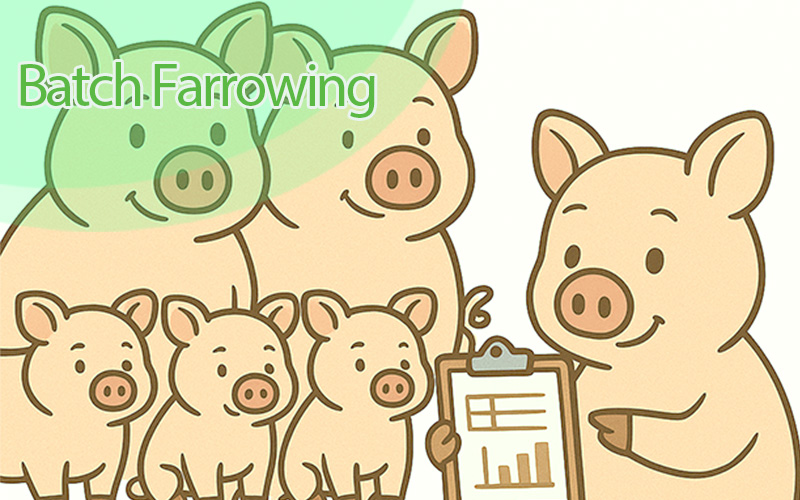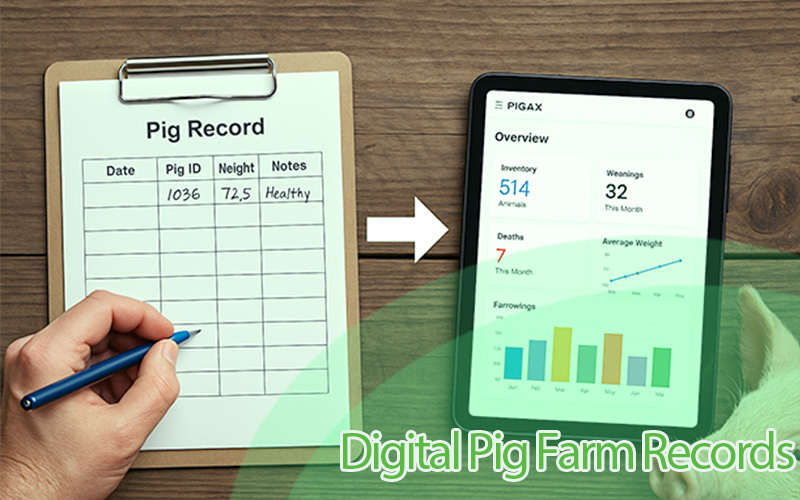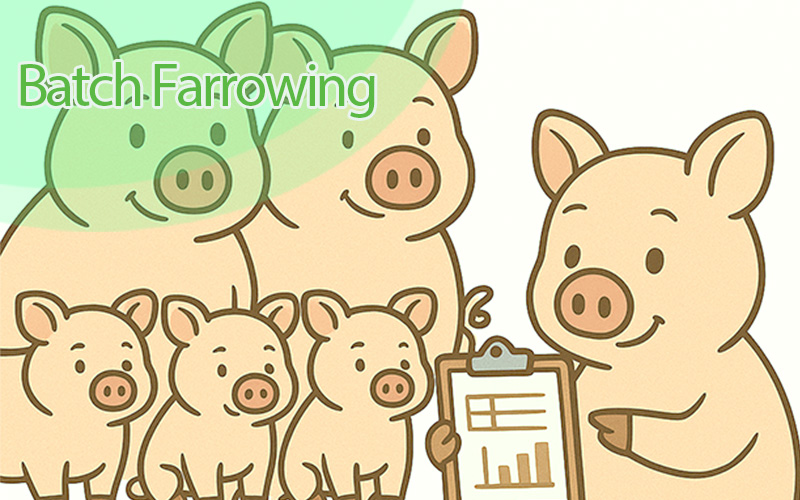The Secrete to a Successful Batch Farrowing with Pigax
If you want to run a smart and productive pig farm, keeping good records is just as important as feeding your pigs. One of the best ways to bring structure and efficiency to your farm is by using batch farrowing—a system that lets you group and manage sows by specific schedules. With the help of swine management software like Pigax, this strategy becomes easy to apply, monitor, and improve over time.
In this blog, you'll learn how batch farrowing works, why it's a game-changer for modern farms, and how to use Pigax to keep everything in order. Whether you're managing a small family operation or a large swine farm, this guide will help you make better decisions, reduce stress, and grow your results.
What is Batch Farrowing and Why It Matters
Batch farrowing is a system where you divide your sows into groups that farrow (give birth) around the same time. Instead of having piglets born randomly throughout the month, you time breeding so that groups of sows farrow on the same schedule—every 2, 3, or 4 weeks, for example.
The goal is to create a predictable routine that allows you to manage feed, space, labor, and care more efficiently. Instead of moving from one farrowing pen to another every few days, your staff can focus on one batch at a time. This makes things like weaning, cleaning, and treatments more organized. The result? Healthier piglets, reduced disease spread, better weaning weights, and improved productivity across the board.
In the swine industry, it is common knowledge that a farrowing operation without order has already failed. Some of the core principles behind batch farrowing include synchronizing breeding and farrowing events, setting a clear calendar of sow cycles, and organizing work based on these batches. You need discipline and accurate records to make this system work—but with the right tools, it becomes second nature.
The Importance of Record-Keeping in Batch Farrowing
Batch farrowing come with numerous benefits to pig farmers who use it effectively. Let us go through a few of the benefits of batch farrowing.
Improved Piglet Management and Uniformity
Batch farrowing brings uniformity to the piglets born, as they are all close in age. That uniformity plays a critical role in streamlining care, feeding schedules, and health monitoring. When all piglets in a group are the same age, it becomes easier to apply a single feeding program, wean them at the same time, and evaluate their performance collectively. This improves consistency in growth and simplifies the identification of underperforming piglets.
Efficient Labor Use
One of the most significant advantages of batch farrowing is the efficient use of labor. Farrowing assistance, piglet processing (such as giving iron shots or castration), weaning, and cleaning are done in planned intervals rather than randomly throughout the year. Workers can prepare and manage farrowing rooms as a unit, focus all attention on one group of animals at a time, and reduce time wastage and fatigue. The structured nature of batch systems ensures the entire team knows what to do and when to do it.
Enhanced Biosecurity and Disease Control
Another key benefit is the improved biosecurity and disease control it offers. Batch farrowing allows farms to operate under an “all-in, all-out” system. This means that once a batch moves out of a pen or section, that area can be thoroughly cleaned and disinfected before the next group enters. This practice breaks disease cycles and lowers the chances of infections being passed from older to younger animals. It also reduces chronic disease issues that often stem from continuous animal mixing.
Improved Production Planning and Predictability
From a planning standpoint, batch farrowing allows for better predictability and organization. Knowing in advance when sows will farrow, when piglets will be weaned, and when they will be ready for market or transfer allows farmers to plan feeding programs, staffing, treatments, and sales. It also makes it easier to forecast income, match pig sales with market demands, and plan breeding schedules for maximum productivity.
Optimized Use of Facilities and Space
Facilities are also better utilized under a batch farrowing system. Pens, feeders, and water systems are used more efficiently because animals flow through them in structured cycles. This minimizes overcrowding and underuse, leading to better animal welfare and reduced stress levels. The system helps avoid bottlenecks in housing and ensures each production phase gets the right amount of space and attention.
Easier Health Interventions and Monitoring
When animals of the same age are grouped together, monitoring and treating them becomes far more effective. Veterinary interventions such as vaccinations, deworming, and disease checks can be done in one sweep. It’s easier to notice growth issues, identify infections, and take quick action before diseases spread. The health of the herd becomes more manageable because caretakers deal with similar health challenges across the batch instead of juggling many different age groups at once.
Better Sow Reproductive Management
Sow reproductive performance also improves with batch farrowing. After piglets are weaned, sows return to heat around the same time, making heat detection and breeding more efficient. Artificial insemination or natural mating can be coordinated in one go, reducing variability and maximizing fertility outcomes. It’s easier to assess which sows are performing well and which ones need to be culled, based on clear reproductive timelines.
Improved Record-Keeping and Data Analysis
Finally, record-keeping becomes more organized and data analysis more meaningful. With batches, each group can be tracked from farrowing to finishing. Farmers can easily compare performance indicators like weaning weights, mortality rates, and feed conversion. Trends and problems are easier to spot, and decisions are backed by clear, batch-specific insights.
How to Do Batch Farrowing
Setting up batch farrowing on your farm requires a bit of planning, but once it’s in place, it makes your entire operation more manageable.
Set batch number and schedule: The first step is deciding how many groups or "batches" you want. Many farms choose a system where farrowing happens every three or four weeks. This depends on how many sows you have and the size of your farrowing space. The idea is to fill your farrowing pens at once, care for all piglets in that group together, then clean and prepare the space for the next batch.
Breeding in Batches: Instead of breeding sows individually throughout the year, they are grouped and bred within a specific timeframe, creating a "batch". This batch breeding then allows the sows and gilts in a batch to cared for properly at the same time. That means synchronizing sow weaning and heat detection so they’re ready to be bred at the same time. You can use heat detection records and, if necessary, hormonal treatments to align their cycles. Once they’re bred, you know that those sows are part of the same batch and will farrow around the same date, usually 114 days later.
Silmutanous Farrowing: After sows are bred in batches, multiple sows within a designated batch give birth (farrow) at approximately the same time—usually within a narrow window of a few days usually within 2 or 3 days. This synchronization results in a uniform group of piglets that are all born around the same period and are therefore similar in age, size, and development stage.
When piglets are born in a uniform group, it simplifies many aspects of farm management, including weaning schedules, vaccination programs, and feeding routines. You can treat the group as a single unit, which reduces labor intensity, streamlines care procedures, and minimizes the chance of errors. This uniformity also allows you to apply all-in/all-out management practices more effectively—cleaning and disinfecting pens in between groups without overlap.
Tracking Batch Farrowing with Pigax
Pigax is designed to make batch farrowing simple and stress-free. The first thing you’ll do is register your sows into the system and group them into batches based on their breeding dates. You can label each batch and track them separately, so you never lose sight of what stage each group is in.
Inside the Pigax dashboard, you’ll see a clear timeline of pregnant pigs in each batch. It shows you when the sows were bred, when they’re due to farrow, and when the piglets are expected to be weaned. The system also allows you to set alerts and reminders for important events like expected farrowing dates or weaning windows. This way, nothing slips through the cracks.
As farrowing day approaches, you can prepare your pens, order the right feed, and make sure all supplies are ready. After farrowing, you can record the number of piglets born alive, stillborn, or weaned—all linked to that batch. These records help you evaluate how successful each cycle was and compare results across batches.
When you manage batch farrowing in Pigax, you can also generate batch reports that give you a full overview of the group’s performance. These reports help you make smarter decisions for future cycles. For help using these features, you can follow our detailed guide in the documentation.
Common Mistakes to Avoid and Best Practices
Even though batch farrowing makes your job easier, there are some traps you should watch out for. One common mistake is failing to close or update batches. When you leave old batches open in the system, you can accidentally mix them with new ones. This causes confusion and messes up your reports.
Another mistake is missing farrowing dates because no one checked the reminders or kept the schedule updated. Always make it a habit to review your dashboard weekly and confirm upcoming farrowing events. You can also assign tasks to your staff using Pigax so everyone knows what to expect.
Incomplete piglet records are another issue. If you only record live births but skip stillbirths or piglet deaths, your data becomes unreliable. This makes it harder to judge sow performance and batch success. Take the extra few minutes to log everything—you’ll thank yourself later.
To avoid these problems, stick to a routine. Review your calendar regularly, use alerts, and always close a batch once all events are done. Lean on Pigax's features like auto-reports, health logs, and team collaboration tools to stay in control.
Want to take your swine management to the next level? Pigax is here to help you plan, record, and grow smarter. If you're not already using batch farrowing, now’s the perfect time to start. With the right strategy and the right tools, you can boost your productivity, improve animal welfare, and make your work more enjoyable every day.




